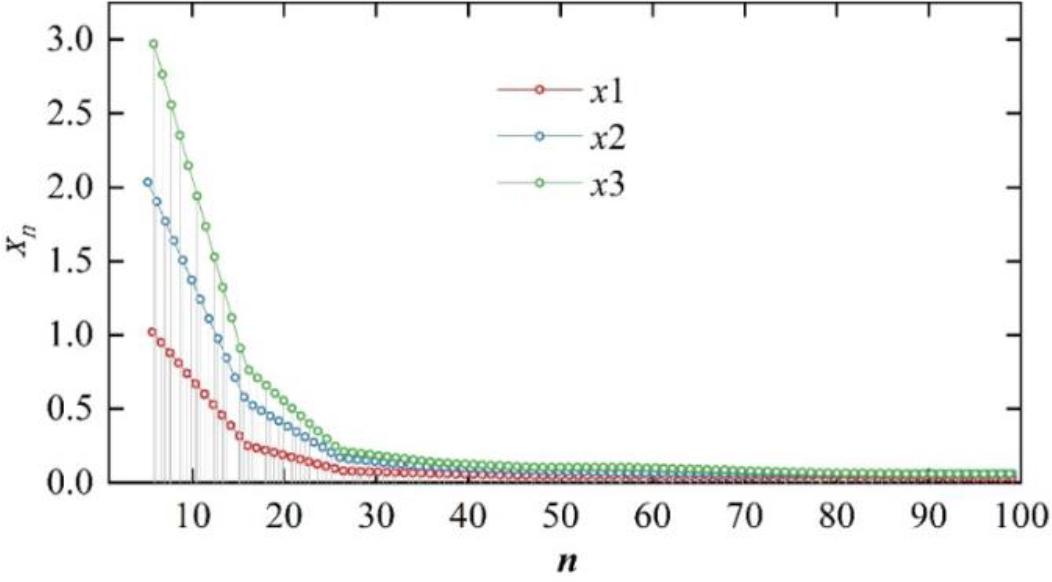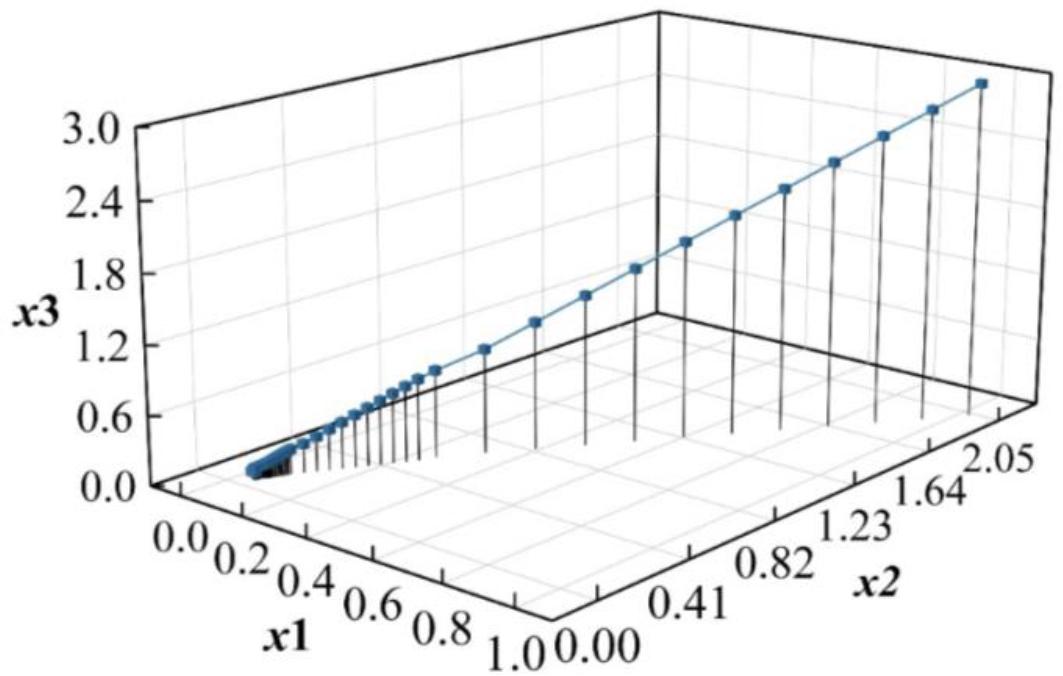A study of asymptotically non-expansive mapping iteration and weakly convergent approximation methods based on Banach spaces
Data publikacji: 03 lut 2025
Otrzymano: 25 wrz 2024
Przyjęty: 04 sty 2025
DOI: https://doi.org/10.2478/amns-2025-0040
Słowa kluczowe
© 2025 Zhirong Guo, published by Sciendo
This work is licensed under the Creative Commons Attribution 4.0 International License.
The theory of stationary points is an important part of the rapidly developing theory of nonlinear generalized functional analysis, and it is also one of the key problems that people have been paying attention to. It is very closely related to many fields of modern mathematics, especially in the various branches of applied mathematics. Almost all have a wide range of applications [1–4]. It plays a very important role in establishing all kinds of equations, such as all kinds of linear or nonlinear, differential equations, integral equations, and all kinds of operator equations, as well as the existence and uniqueness of solutions to variational inequalities and variational inclusion problems [5–8].
The iterative process of immovable points of asymptotically non-expansive mappings in Banach spaces is an important research topic in general function analysis. Banach gave the first immovable point theorem, Mann introduced the Mann iteration method to study the approximation problem of immovable points of non-expansive mappings [9–11], and Ishikawa introduced Ishikawa iteration sequences for the proposed non-expansive tight mappings in the real Hilbert space and proved the corresponding convergence theorem. The convergence of iterated sequences of nonlinear operators is a very active topic that has been widely studied by many scholars at home and abroad [12–15]. The research focuses more on the three aspects of space framework, nonlinear operators and convergence of iterative sequences, which leads to many important results. In recent years, the theory of iterative approximation of nonlinear mappings with immovable points has been rapidly developed [16–19].
In this paper, a class of iterative algorithms for mapping immovable point problems with asymptotically non-expansive expansion is studied from the perspective of immovable point problems. Hybrid iterative sequences about two families of asymptotically non-expansive mappings and hybrid iterative sequences with mean error terms are constructed, and some weak convergence theorems for the convergence of the sequences to a common immovable point are proved under appropriate conditions. Finally, the practical value and the efficiency of the weakly convergent approximation of the hybrid iterated sequence with mean error term are confirmed by its application to solve the zero and equilibrium problems and two arithmetic examples.
In this paper let
If
A Call Call
It is easy to know that a compression mapping is a non-expansive mapping, a non-expansive mapping is an asymptotically non-expansive mapping, and the converse does not hold. In this paper denote by Π
Let ∀ For every
Let ℑ = {
Call ℑ = { Call ℑ = { Such that:
Call ℑ = {
It is easy to see that a non-expansive semigroup is an asymptotically non-expansive semigroup, an asymptotically non-expansive semigroup is an asymptotically non-expansive semigroup, and the converse does not hold. Denote by
Call Let Banach spaces with consistent regular structure are self-inverse; consistently convex and consistently smooth Banach spaces have consistent regular structure. Let
Applying the viscosity technique to implicit midpoint rules for non-expansive mappings, the following semi-implicit algorithm is investigated to build iterative sequences:
Where {
On this basis, the generalised viscous implicit norm is studied and the following iteration format is given:
Where {
Let
Where {
Where {
In order to prove the main result of this paper, it is necessary to introduce the following lemma:
Let
Let
Let
Let For any
Let There exists For ∀
This chapter studies the strong and weak convergence of the iterated sequence {
Let There exists ∀
Then the sequence {
Proof By
In the following we prove that {
Thus, by the Opial condition, we have:
Clearly a contradiction. So
Let
Existence.
Prove that ∀
Define the mapping
∀
ECS for all
One of the
It is not difficult to prove that for all
Here
It follows from Lemma 2:
So for fixing
By lim
So for all
Let
The proof is the same as above.
Let There exists ∀
Then {
Proof Imitating
Thus,
Let There exists ∀
Then {
Proof Using the method given in the proof of
Weak convergence of hybrid iterated sequences has been studied in the previous section, and in this section we study hybrid iterated sequences with an average error term.
Define the iterative sequence {
Where
Let
A Banach space
The Banach space
The Banach space
Let
Let
Let
Under the conditions of Lemma 3, then:
Prove that if we set
Define the mapping
Easy Certificates ∀
Where
By (37) and (38), ∀
In fact, for any
Set
Noted:
It follows from (42) and Lemma 9:
By Lemmas 3 and
Thus in equation (44), fixing
Then let
That is, ∀
Under the conditions of Lemma 3, if
Under the conditions of Lemma 3, if
Proof Since
By Lemma 11,
Now, we show that the sequence {
Thus,
Under the conditions of Lemma 4, if the dual space
Proof The proof of Theorem 1 shows that there exists a subsequence {
Under the conditions of Lemma 4, if
Again, by Lemma 11,
Now, we prove that the sequence {
Zero Problem: Find
0 <
Then {
(H1) for all (H2) for all (H3) for every (H4) is convex and weakly lower semicontinuous for all
Assume that
In this section, two arithmetic examples are given, the first one to illustrate the convergence of the proposed algorithm and the second one will be compared with the convergence rate of several iterative algorithms.
Let the inner product 〈·,·〉 :
Using the algorithm in the theorem, starting from

Two-dimensional graph

Three-dimensional graph
Set
Firstly, the sequence {
When
The sequence {
The sequence {
The numerical comparison of convergence between the algorithms is shown in Table 1 and Figure 3, from which it can be seen that the iterative algorithm (28) converges faster. From Table 1, it can be seen that Algorithm (28) not only converges faster but also converges to zero early compared to the iterations of Algorithms (9), (10) and (12), which do not converge to zero until the 100th term.

Convergence comparison of the iterative algorithm
Numerical comparison of convergence between algorithms
| n | Algorithm 9 | Algorithm 10 | Algorithm 12 | Algorithm 28 |
|---|---|---|---|---|
| 1 | 100 | 100 | 100 | 100 |
| 2 | 39.9973 | 34.9969 | 19.9997 | 4.8332 |
| 3 | 27.9969 | 21.8754 | 9.2945 | 0.4462 |
| 4 | 22.0014 | 15.7271 | 5.4182 | 0.043 |
| 5 | 18.3379 | 12.1843 | 3.5687 | 0.0064 |
| 6 | 15.8334 | 9.9048 | 2.5476 | 5E-4 |
| 7 | 14.0063 | 8.3063 | 1.8985 | 1E-4 |
| 8 | 12.6092 | 7.14 | 1.4791 | 0 |
| 9 | 11.49 | 6.2552 | 1.1944 | 0 |
| … | … | … | … | … |
| 96 | 7.3599 | 3.2601 | 0.4099 | 0 |
| 97 | 7.0265 | 3.0455 | 0.3651 | 0 |
| 98 | 6.7271 | 2.8536 | 0.2187 | 0 |
| 99 | 6.4581 | 2.678 | 0.1097 | 0 |
| 100 | 6.2034 | 2.5275 | 0 | 0 |
The main work of this paper is based on the existing results of many scholars, which have been improved, extended, and supplemented.
This paper focuses on the convergence of asymptotically non-expansive mappings under two different iterative sequences, including hybrid iterative sequences and hybrid iterative sequences with an average error term, and some weakly convergent approximation theorems for this iterative sequence are proved in Banach spaces.
In addition, the main results are applied to the zero and equilibrium problems, and a numerical example is given for convergence analysis. Compared with the rest of the iterative sequences, the hybrid asymptotically non-expansive mapping iterative sequences with averaging error terms not only have faster convergence but also converge to zero in advance, and they can be better applied in practice.
The current study is focused on the Banach space. In the research problem combined in this paper, the convergence of iterative algorithms in two or even more spaces, such as the study of iterative algorithms, provides new ideas for subsequent research. Iterative algorithms have practical significance in real-life applications, such as image reconstruction and signal processing. The optimization of these real-life practical problems and in-depth application-oriented research also require further consideration.
